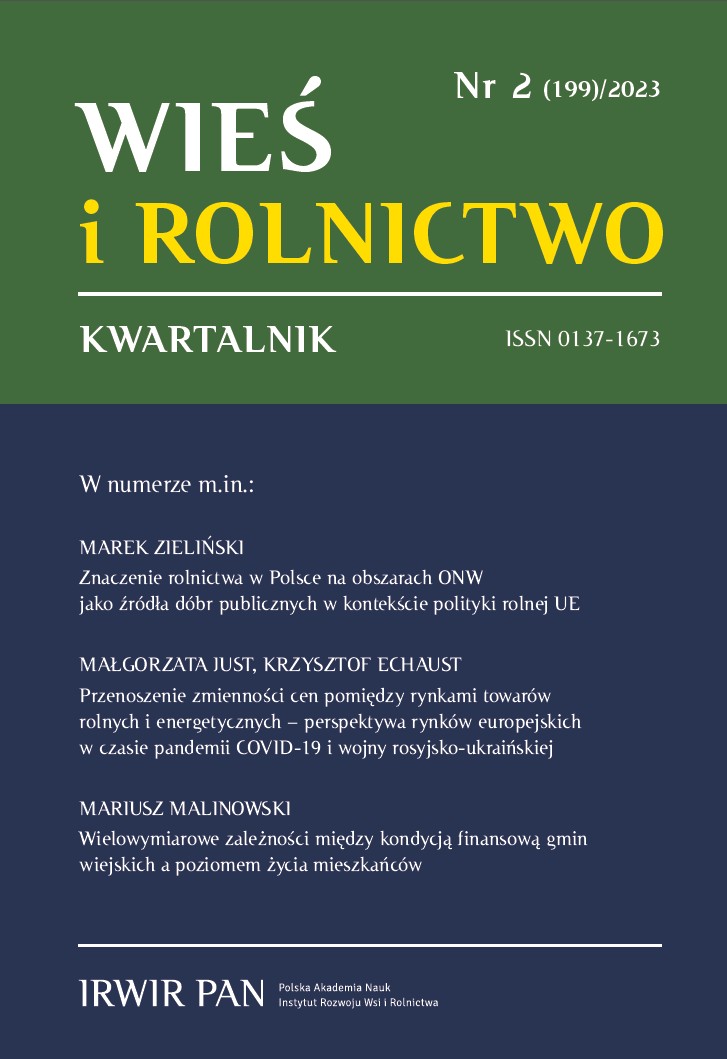Economic Analysis of the Determinants of Citrus Exports in South Africa Post the Era of Trade Liberalisation
DOI:
https://doi.org/10.53098/wir022023/06Keywords:
export, trade liberalisation, cointegration, citrus, stationarityAbstract
The purpose of the study was to analyse the determinants of South African citrus exports post era of trade liberalisations using secondary data from 1996 to 2018. The Johansen Cointegration model was used to test the long-run relationship between the citrus export and the determinants in the post era of trade liberalisation and Ordinary Least Squares regression was used to determine the relationship between citrus export in South Africa and the selected determinants post the era of trade liberalisation. The results of the Johansen Cointegration model show the existence of a long-run equilibrium relationship between citrus exports and the determinants of South African citrus exports. The Ordinary Least Squares regression results provided evidence that citrus production and citrus world market prices are the major influencers of citrus export in South Africa. The Department of Agriculture and the Citrus Associations should make initiatives to ensure an increase in citrus production by promoting development programmes for the citrus producers.
References
Ahmad B., Mehdi M., Ghafoor A., Anwar H. (2018). Value chain assessment and measuring export determinants of citrus fruits in Pakistan: An analysis of primary data. Pakistan Journal of Agricultural Sciences, 55 (3), 691–698. DOI: https://doi.org/10.21162/PAKJAS/18.6056
Alessandria G., Choi H. (2014). Establishment heterogeneity, exporter dynamics, and the effects of trade liberalisation. Journal of International Economics, 94 (2), 207–223. DOI: https://doi.org/10.1016/j.jinteco.2014.08.006
Alipour H., HoseinBeyki A., Jahed M., Rahnama H., Sharifnia M. (2013). A review on citrus production and export marketing strategies in Mazandaran province, Iran. Middle-East of Scientific Research, 14 (10), 1375–1380.
Bhattacharya P. (2019). Determinants of export competitiveness of fresh fruits in India. International Journal of Sustainable Economy, 11 (1), 61–80. DOI: https://doi.org/10.1504/IJSE.2019.10016841
Boansi D., Lokonon B. O.K., Appah J. (2014). Determinants of agricultural export trade: Case of fresh pineapple exports from Ghana. British Journal of Economics, Management and Trade, 4 (11), 1736–1754. DOI: https://doi.org/10.9734/BJEMT/2014/10773
Das S., Roberts M.J., Tybout J.R. (2007). Market entry costs, producer heterogeneity, and export dynamics. Econometrica, 75 (3), 837–873. DOI: https://doi.org/10.1111/j.1468-0262.2007.00769.x
Davidson R., MacKinnon J.G. (2004). Econometric Theory and Methods. New York: Oxford University Press.
FAO [Food and Agriculture Organisation] (2021). Citrus Fruit Statistical Compendium 2020. Food and Agriculture Organization of the United Nations: Rome.
Gianessi L., Williams A. (2012). High-value South African citrus exports rely on fungicides. Crop Protection Research Institute, 1.
Granger C.W., Newbold P. (1974). Spurious regressions in econometrics. Journal of Econometrics, 2 (2), 111–120. DOI: https://doi.org/10.1016/0304-4076(74)90034-7
Johansen S. (1988). Statistical analysis of cointegration vectors. Journal of Economic Dynamics and Control, 12 (2–3), 231–254. DOI: https://doi.org/10.1016/0165-1889(88)90041-3
Ju J., Wu Y., Zeng L. (2010). The impact of trade liberalisation on the trade balance in developing countries. IMF Staff Papers, 57 (2), 427–449. DOI: https://doi.org/10.1057/imfsp.2009.19
Louise B. (2020). Citrus production. http://southafrica.co.za/citrus-production.html. [accessed: 15th August 2020].
Mambo J., Faccer K. (eds.) (2017). South African Risk and Vulnerability Atlas: Understanding the Social & Environmental Implications of Global Change. African Sun Media.
Ostry J.D., Rose A.K. (1992). An empirical evaluation of the macroeconomic effects of tarrifs. Journal of International Money and Finance, 11 (1), 63–79. DOI: https://doi.org/10.1016/0261-5606(92)90021-O
Perman R. (1991). Cointegration: An introduction to the literature. Journal of Economic Studies, 18 (3), 3–30. DOI: https://doi.org/10.1108/EUM0000000000151
Phaleng L.T. (2020). Determinants of South Africa’s fruit export performance to West Africa: A panel regression analysis. Doctoral dissertation, North-West University (South Africa).
Raats J. (2017). Sitruskwekers skep asem ná droogtejaar. http://www.landbou.com/nuus/sitruskwekers-skep-asem-na-droogtejaar [access: 15th August 2020].
USDA [United States Department of Agriculture] (2022). Citrus Annual. SF2022-0043. DownloadReportByFileName (usda.gov) [access: 15th February 2023].
Verter N., Bečvářová V. (2014). Analysis of some drivers of cocoa export in Nigeria in the era of trade liberalisation. Agris on-line Papers in Economics and Informatics, 6 (4), 208–218.
Vink N. (2004). The influence of policy on the roles of agriculture in South Africa. Development Southern Africa, 21 (1), 155–177. DOI: https://doi.org/10.1080/0376835042000181462
Zakaria M. (2014). Effects of trade liberalisation on exports, imports and trade balance in Pakistan: A time series analysis. Prague Economic Papers, 23 (1), 121–139. DOI: https://doi.org/10.18267/j.pep.476











